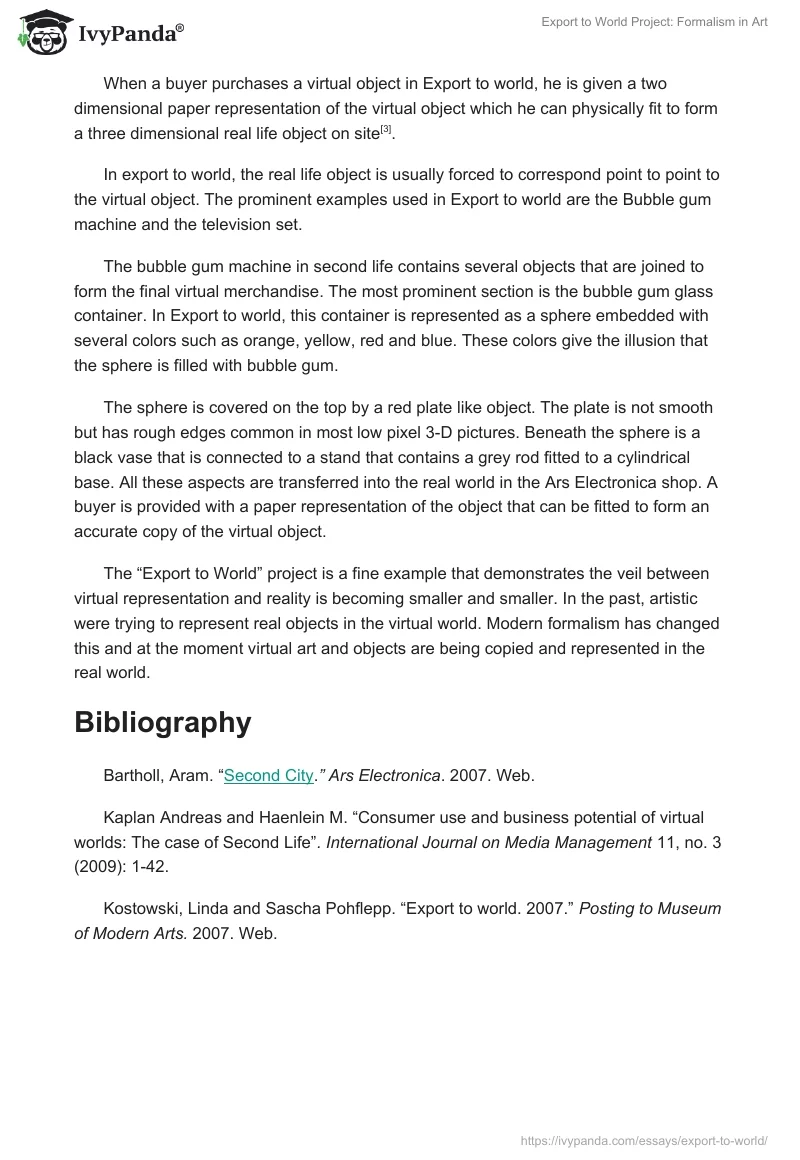In art, formalism describes the concept that the artistic merit of a work of art is completely established by its form, its medium, and its visual characteristics. Formalism stresses on the elements of the works of art that include shape, color, texture and line while avoiding concepts of realism such as content and context. In the modern world, visual art has been very prominent.
In visual art, formalism denotes a concept that puts forwards that everything required to understand a work of art is enclosed inside the work of art. Formalism is a method of understanding a work of art that reduces the importance of context in a work of art. In this paper, I intend to look at the Export to world project displayed at the Museum of Modern Arts (MoMA) in New York City and located in Ars Electronica in Linz, Austria.
Formalism in the modern world has taken a huge leap and focuses on bringing virtual art and object into the real world. Unlike modeling natural objects that utilizes common paths and well-known tools, export to world shows that modeling man-made phenomena can be engaging and quite interesting.
Export to the world is an artistic project that seeks to copy virtual objects from second life and export them to real world by converting them into paper craft models. The project was created on behalf of Ars Electronica by Linda Kostowski and Sascha Pohflepp. Export to world aims at investigating the unclear separation between the virtual world and the real world. The project tries to bring to life the design and production of virtual objects into the real world for observation.
In export to world, the form of the virtual object is of the main importance. At the shop in Ars Electronica in Linz, buyers can buy purchased or custom-made virtual objects that are exact replicas to those in the second life market. These real life representations of virtual merchandise are exact copies that even contain the flaws inherent in copying.
When a buyer purchases a virtual object in Export to world, he is given a two dimensional paper representation of the virtual object which he can physically fit to form a three dimensional real life object on site.
In export to world, the real life object is usually forced to correspond point to point to the virtual object. The prominent examples used in Export to world are the Bubble gum machine and the television set.
The bubble gum machine in second life contains several objects that are joined to form the final virtual merchandise. The most prominent section is the bubble gum glass container. In Export to world, this container is represented as a sphere embedded with several colors such as orange, yellow, red and blue. These colors give the illusion that the sphere is filled with bubble gum.
The sphere is covered on the top by a red plate like object. The plate is not smooth but has rough edges common in most low pixel 3-D pictures. Beneath the sphere is a black vase that is connected to a stand that contains a grey rod fitted to a cylindrical base. All these aspects are transferred into the real world in the Ars Electronica shop. A buyer is provided with a paper representation of the object that can be fitted to form an accurate copy of the virtual object.
The “Export to World” project is a fine example that demonstrates the veil between virtual representation and reality is becoming smaller and smaller. In the past, artistic were trying to represent real objects in the virtual world. Modern formalism has changed this and at the moment virtual art and objects are being copied and represented in the real world.
Bibliography
Bartholl, Aram. “Second City.” Ars Electronica. 2007. Web.
Kaplan Andreas and Haenlein M. “Consumer use and business potential of virtual worlds: The case of Second Life”. International Journal on Media Management 11, no. 3 (2009): 1-42.
Kostowski, Linda and Sascha Pohflepp. “Export to world. 2007.” Posting to Museum of Modern Arts. 2007. Web.


